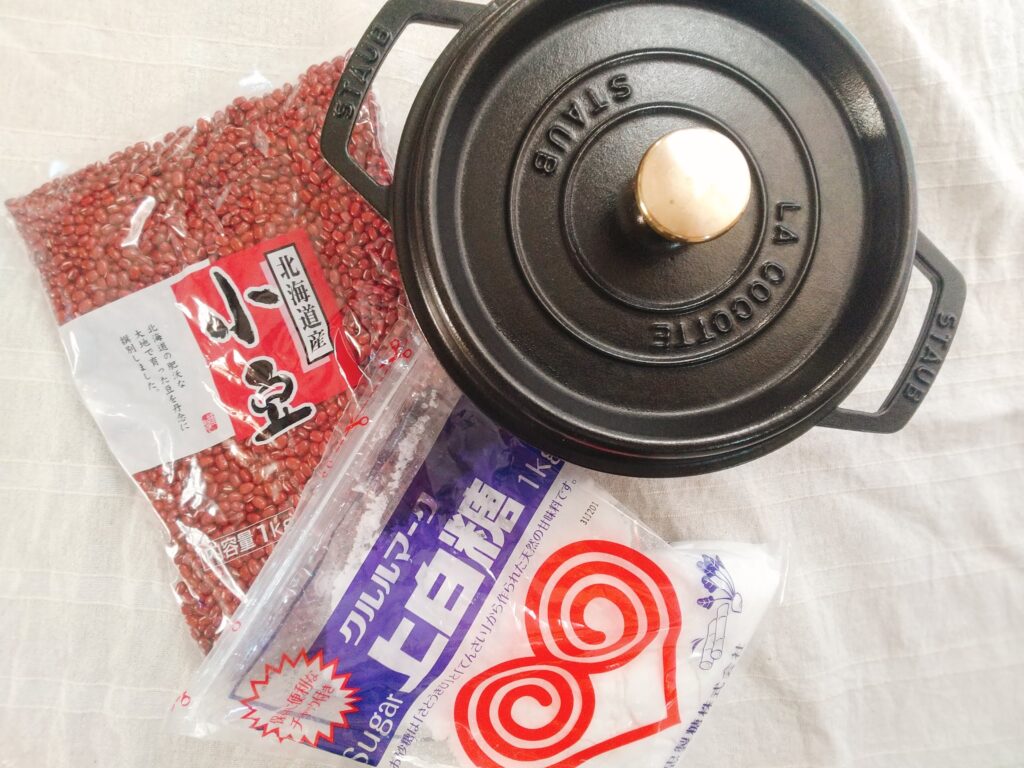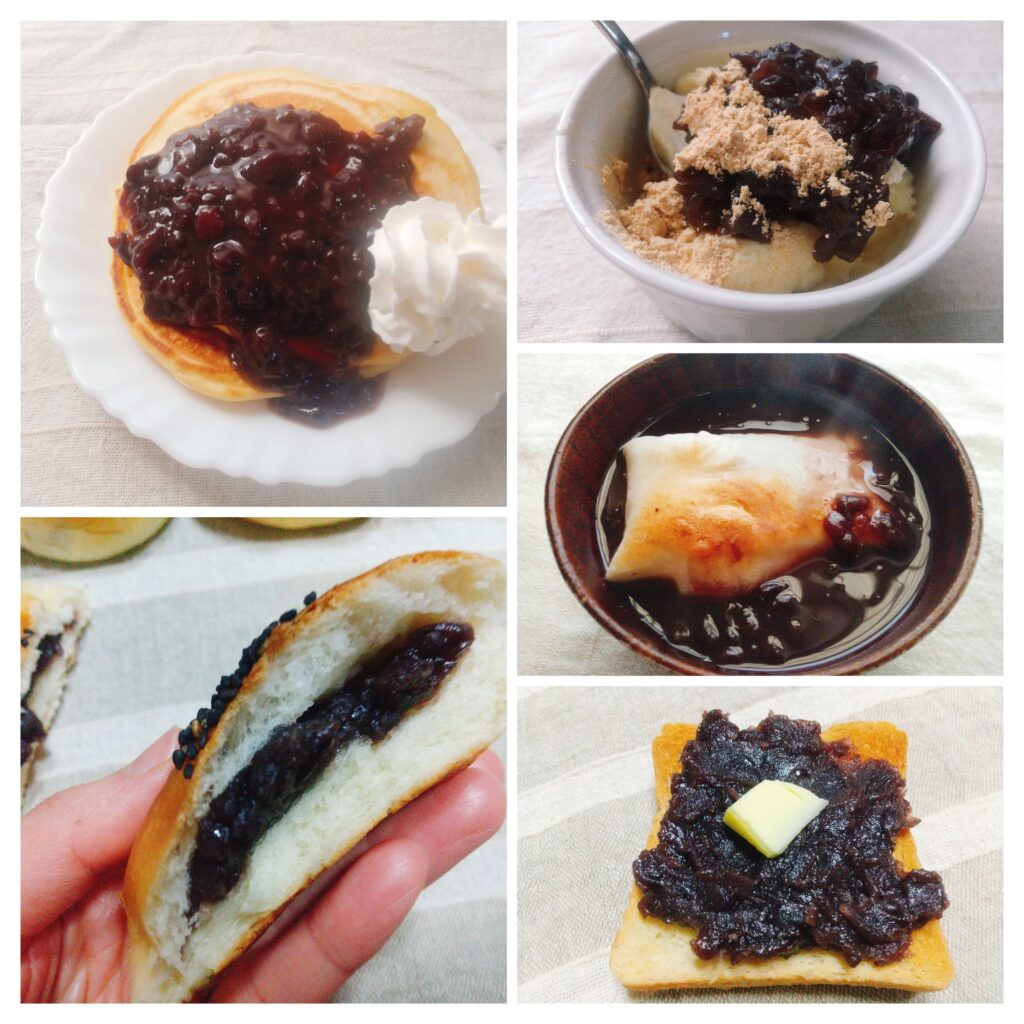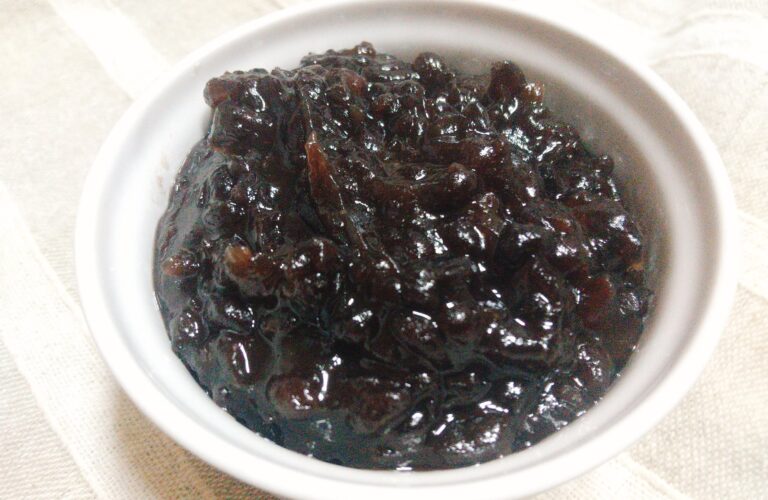Anko is the national favourite flavour in Japan, maybe in Asia. It is sweetened bean paste which is used in a variety of Japanese sweets and we also spread it on toast, put on ice cream, and add in coffee instead of sugar. This humble bean paste actually can bring anything to the next level!
What is Anko?
Anko is usually made of azuki beans which are a kind of beans grown in mainly East Asia. In Japan, they are mostly used for making Anko. Some savoury dishes use azuki beans but it’s not so common. The process of making Anko is pretty simple, boil the beans and sweeten them with sugar, but it takes quite a bit of time to make the beans soft. What Anko tastes like is difficult to describe, it’s obviously sweet as it contains a lot of sugar, but has a bit of savouriness from azuki beans. So, if you haven’t tasted Anko before, you’ll be surprised at how unique it tastes!
What type of Anko are there?
There are many kinds of Anko out there, for example…
Shiro An (white bean paste), Uguisu An (green bean paste), Zunda An (edamame bean paste) and more!
Even in the Azuki bean paste that I’m talking about here in this recipe, there are mainly two types of Anko, Tsubu An which is a chunky one like the photo below and this recipe is for Tsubu An. Koshi An is a silky Azuki bean paste which is made from strained cooked beans
Ingredients You Will Need
Azuki Beans – Nowadays, you can buy azuki beans at Asian grocery stores and online.
Sugar – White sugar is preferable but you can use any kind of sugar you like.
Baking Soda – This is optional but I always use it to make the skin of every bean soft.
Salt – Salt enhances the flavour of anything! A little bit of salt can make a big difference.

What CaMake with Anko?
Anko is really versatile and goes well with different kinds of things!

Anko Pancakes – I’m a huge pancake lover and Anko is my favourite topping on my pancakes! I usually loosen up my Anko with a bit of hot water to make it sauce-like.
Anpan – Anpan is a bun filled with Anko that is very popular in Japan.
Ice cream with Anko – Anko and Kinako( soybean powder ) on vanilla ice cream is amazing.
Shiruko – This is the traditional way of eating Anko. All you have to do is put some Anko and water in a saucepan to make Anko soup and pour it over a toasted Mochi.
Anko on Toast – Anko and Buttter are good friends with a piece of toast!
Tips for making Anko
Make sure to cook every bean thoroughly before adding sugar!
Because once you add sugar, the beans stop becoming soft. If you add sugar to beans before they get soft, your Anko will have firm beans in it.
A pinch of salt makes a big difference
Even if you are making sweet food, salt is very important because it enhances any flavour whether it is savoury or sweet.
Do not make your Anko too thick
After you add sugar, you have to cook the mixture for quite a long time but please make sure to stop cooking Anko before it reaches your desired texture. This is because Anko thickens a lot as it cools down.
Q & A
How long does homemade Anko last?
Transfer the Anko to a jar or other airtight container. Store it in the refrigerator for a week or longer. If you want to reduce the amount of sugar in your Anko, please keep in mind that your Anko won’t last as long.
Can I make my Anko less sweet?
Yes, you can adjust the sweetness of your Anko by reducing the amount of sugar you add. It’s up to you!
Can I freeze my Anko?
Yes, Anko can be frozen perfectly for up to 2 months. Just make sure to put it in an airtight container or ziplock bag to prevent it from getting freezer burn. Thaw it at room temperature for about 1 hour or in the fridge overnight when you need it.
More Asian Sweet Recipes
Vegan Tangzhong Anpan (Japanese Red Bean Buns)
Vegan Chinsuko (Okinawan Shortbread Cookies) ちんすこう
Strawberry and Nutella Daifuku Mochi (ヌテラ苺大福)
Chinese Steamed Black Sesame Red Bean Buns (Vegan)
Eggless Matcha and White Chocolate Mousse

How to make Anko (Sweet Red Bean Paste)
Equipment
- 1 Laege pot
- 1 Wooden Spoon or Rubber Spatula
- 1 colander
Ingredients
- 200 g Azuki Beans
- 300 g Granulated Sugar
- ½ tsp Baking Soda
- ¼ tsp Salt
Instructions
- Rinse your azuki beans under running water to make sure the beans are clean. Put azuki beans in a large pot and fill the pot up with enough water that covers the beans by at least 1 inch.
- Bring the water and azuki to a boil for 5 minuites and drain the water using a colander. Put the beans back into the pot and refill with water that covers the beans by about 1 inch. Bring the water to a boil again and once it boils, add 1/2 tsp of baking soda and turn the heat down and simmer it for about 50min to 1 hour to cook the beans all the way through. How long it takes really depends on the condition of the beans and your stove. Keep an eye on the pot so that when the water evaporates too much you can top up with water.
- You can check if the beans are properly cooked by rubbing a bean with your forefinger and thumb. If the bean is smashed easily and not grainy, the beans are cooked. But do be careful not touching the beans straight away from your pot. Always put the bean to a cup of water with a spoon first then touch with your fingers. I really recommend testing not one but several beans by this way because you want to make sure all the beans are soft at this stage.
- Once the beans are cooked, turn the heat off and put a lid on the pot then leave for 30 minutes. After that, drain the water with a colander and put it back to the pot with sugar. Turn the heat to medium heat and dessolve the sugar then cook it for about 10 to 20 minutes stirring constantly to thicken the beans and sugar mixture. The more you cook the thicker your Anko will be. Make sure your spatula or wooden spoon has long handle because Anko is incredibly hot, it's like caramel!
- When your Anko has thickened, add salt and give it a stir, take off the heat and spread on a plate or a tray to cool it down. Do not forget hot Anko looks runny, but as it cools, it gets much thicker, so you want to take account of it before you overcook your Anko. Cooled Anko shoud be thicker than custard. Now, you have homemade anko!




